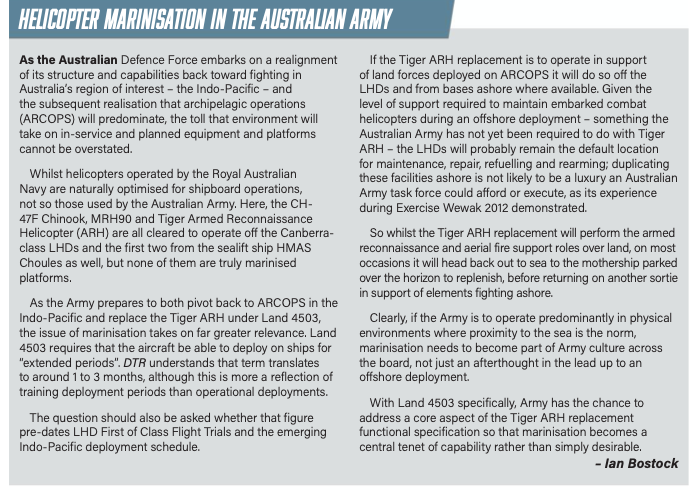By Robbin Laird
In my last piece, which addressed the question of the way ahead for the Australian army in the evolving approach of the ADF to Indo-Pacific operations, the question was posed: Will the Australian Army fully embrace amphibiosity?
Will they shift from the USMC’s legacy position of amphibious ships as greyhound buses to an area of operations to operating from sea and expeditionary bases?
Ian Bostock, the editor of Defence Technology Review, has provided a series of articles over the past few months in his journal which highlight a variety of ways to conceptualize how the Australian Army might do so.
The lead article in this rethink was published in his May issue and was entitle “Archipelagic Operations: Why Australia Needs to Get on Board.”
With the new strategic focus on prioritizing Australia’s regional defense, a key capability for the ADF will be their capabilities to fight in an archipelago. This May article looks at how the ADF could prepare itself to do so.
The author, who is an unidentified member of the Australian Department of Defence, argues that the Army’s concept of operations is to deliver a battlegroup as an “entry force for a follow-on brigade, for which no shipping exits, naval or commercial.”
The author poses a core question: “How can Australia make itself capable of fighting in an archipelago?”
The author then goes on to provide an assessment of how to do so, by starting with the nature of archipelagic operations (ARCOPS). “The key is having adequate surveillance and target acquisition plus the mobility necessary for distributed operations, which the force can be bypassed.” The author adds that “the ADF still sees the archipelago as a series of land problems connected by se transport, rather than as a mutually interdependent environment. That reflects in its persistent attraction to heavyweight equipment ill-suited to archipelagic manoeuvre.”
This would require a highly mobile force which can tap into distributed C2/ISR and have both organic and kill web available strike capability.
“Where can Australia least afford to lose: in the archipelagos on its doorstep or on some distant continental land mass?”
In the months, since the publication of the May 2020 article, Bostock provides a number of insights with regard to how the ADF might embrace such capabilities for the Australian Army to be able to deliver integrated but distributed capabilities to prevail in ARCOPS;
In the June 2020 issue, Bostock addresses the question of helicopters and marinsation. After an article which provides a deep dive on what makes a military helicopter truly marinized, Bostock provides this argument:

In the June 2020 issue, Bostock highlighted a Royal Australian training event where the amphibius fleet operated with support ships to deliver an overall combat effect. Certainly an effective force as far at it goes and that is the point which Bostock underlines,
There are too few ships “to provide capability across a northern archipelago 5,000 kms wide, 2,000 km deep and made up of thousands of individual land masses, large and small.”
He argued that the RAN needs to introduce “a fleet of smaller, cheaper, minimally-crewed landing vessels and watercraft that make distribute amphibious joint operations in an archipelagic environment possible.”
And in various issues, Bostock addresses the question of the range of land vehicles which can support such a force. The Aussies have shaped indigenous capabilities to produce such a range of vehicles, and, in my view, the question is the focus of the evolving Australian Army: is it upon operating a heavy combat force at distance or a force optimized for mobile and expeditionary operations in the region?
And this takes us to the November 2020 issue which addresses directly the Army’s new landing craft projects. As Bostock argues in opening the November issue: “These new landing craft – to be delivered via Phases 1 and 2 of Land 8710 – will have more payload, greater range and better sea-keeping than the craft they are to replace.
“They will be neither glamorous nor high profile platforms but essential components of Army’s capability aspirations amidst a return to thinking about how Australian forces operate in the Indo-Pacific and engage with the near region.”
In short, Ian Bostock’s journal and his own perspective has contributed significant insight into how amphibiosity can deliver an Australian ARCOPS.
Please visit DTR’s website:
“Defence Technology Review is the region’s premier digital defence magazine, focused on providing defence professionals and key decision makers with current developments in military technology, capability development and leading-edge innovation.
“DTR leads the world in its coverage of numerous major Australian defence procurement projects, and is relied upon as a source of intelligence and reference by both government and industry.”


